SMU Data and Models

Steelmaking raw material prices break cycle in August
Written by Brett Linton
August 23, 2024
Editor’s note: Steel Market Update is pleased to share this Premium content with Executive members. For information on how to upgrade to a Premium-level subscription, contact Luis Corona luis.corona@crugroup.com.
Steelmaking raw material prices have moved in differing directions across August, a change of pace from the declines seen in June and July, according to SMU’s latest analysis.
As of Aug. 21, prices for busheling steel scrap, zinc, and aluminum have risen 5-8% month on month (m/m). Pig iron and shredded scrap prices have remained stable. Iron ore and coking coal were the only products to experience significant monthly decreases, dropping 9-10%.
Prices for all but one raw material (pig iron) are cheaper than they were three months ago, with some products down by 14% or more in that time. Table 1 summarizes the percentage changes from one month, three months, and one year ago for each product.
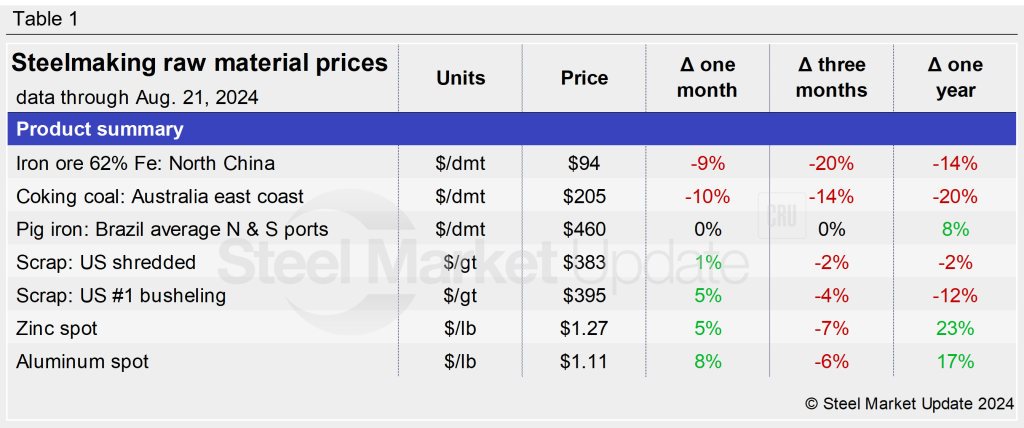
Iron ore
Following an uptick in April and May, the import price of 62% Fe Chinese iron ore fines has moved lower over the past three months. The latest weekly spot price has fallen to $94 per dry metric ton (dmt) delivered North China (Figure 1). This is now the lowest weekly price recorded since November 2022. Iron ore prices have decreased 9% over the past month and are 14% lower than levels seen this time last year.
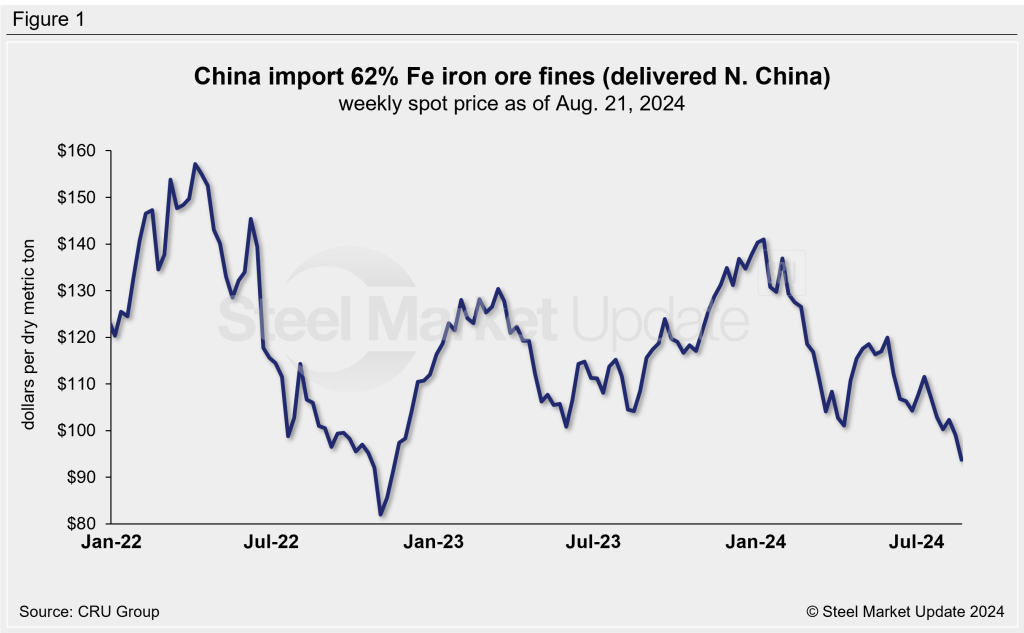
Coking coal
Prices for premium hard coking coal had remained relatively stable between May and July but have eased over the past month. The latest weekly price is down to a two-year low of $205/dmt, having fallen 10% in the last month (Figure 2). Coking coal prices have decreased 14% in the past three months and are 20% less than they were one year prior.
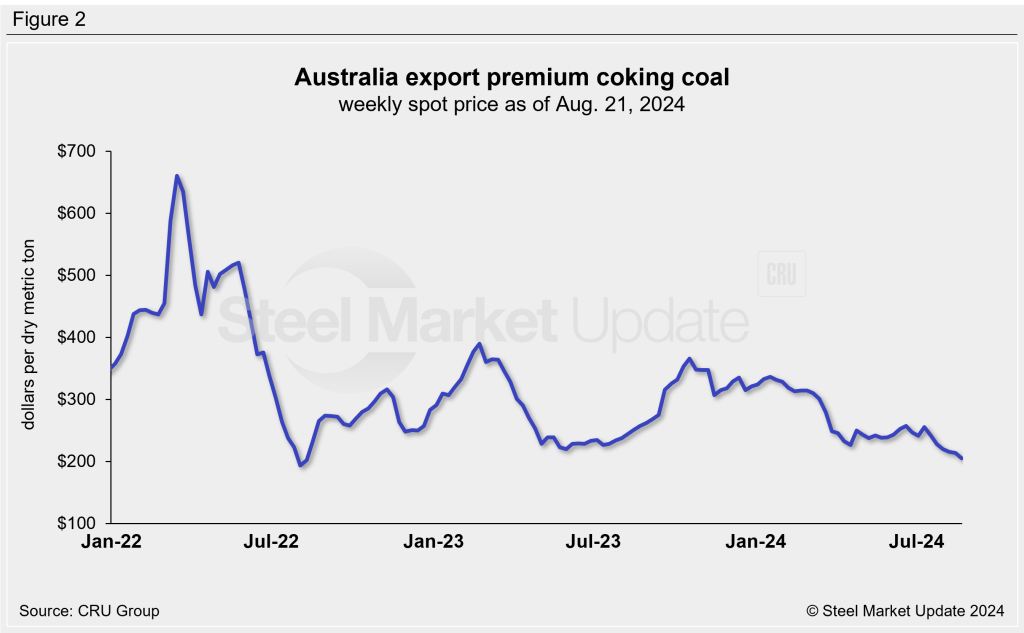
Pig iron
Since stabilizing about a year ago, pig iron prices have overall trended higher since November. Prices were flat from July to August at $460/dmt (Figure 3). Pig iron prices are in line with levels seen three months prior and 8% higher than levels one year ago. Recall that pig iron prices had jumped more than 60% in April 2022 following the invasion of Ukraine by Russian forces, reaching a historic high of $975/dmt.
Note that most of the pig iron imported to the US had come from Russia, Ukraine, and Brazil. This report uses Brazilian prices, averaging north and south port prices.
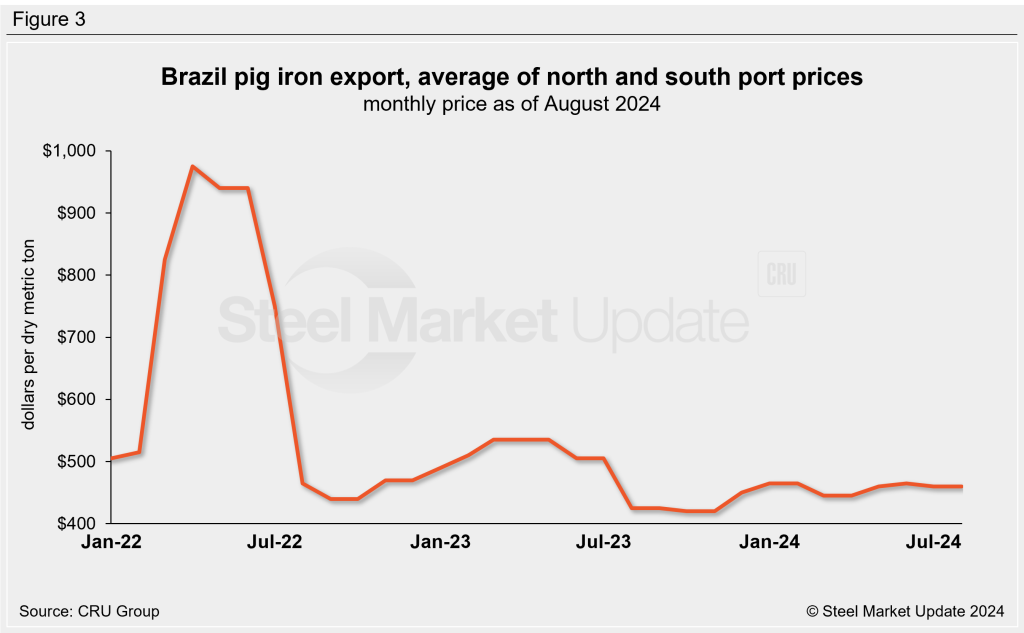
Scrap
Steel scrap prices have generally shifted lower across 2024 following their peak last December. SMU’s busheling and shredded scrap indices picked up steam from July to August; busheling scrap prices rose 5% m/m to $395 per gross ton (gt), shredded scrap ticked up 1% to $383/gt (Figure 4). Scrap tags are down 2-4% from prices recorded three months ago and are 2-12% lower than this time last year.
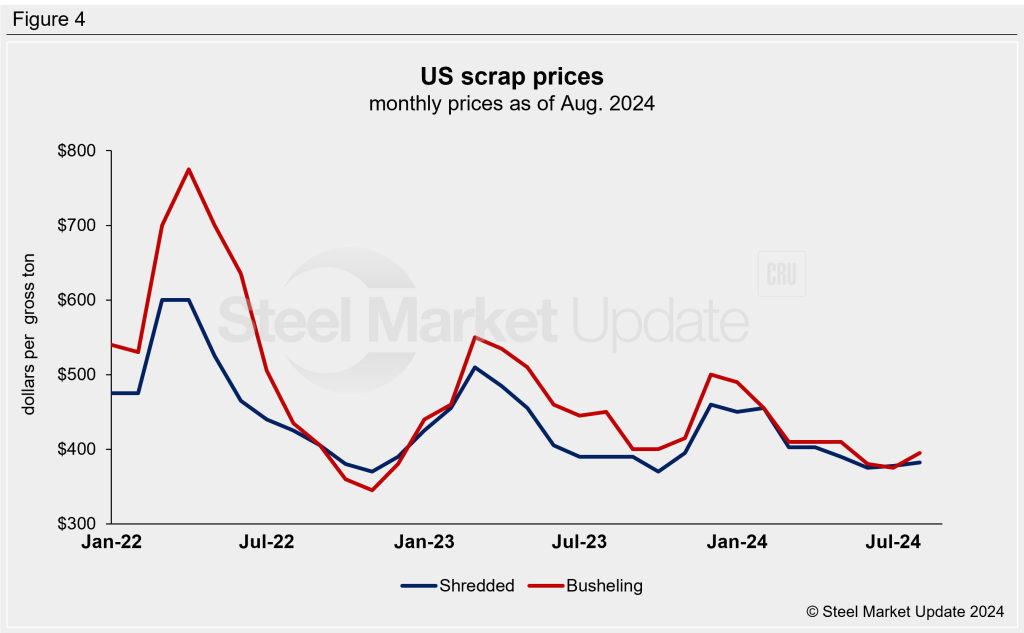
Changes in the relationship between scrap and iron ore prices offer insights into the competitiveness of integrated mills, whose primary feedstock is iron ore, compared to mini-mills, whose primary feedstock is scrap. Figure 5 shows the prices of mill raw materials over the past three years.
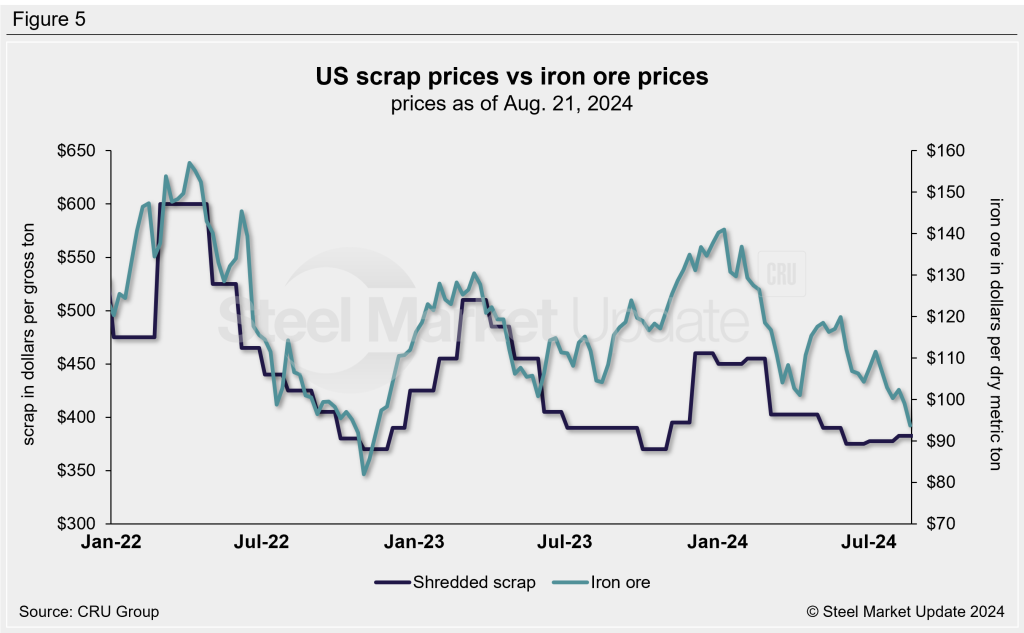
To compare these two feedstock materials, SMU divides the shredded scrap price by the iron ore price to calculate a ratio. A high ratio favors the integrated producers and a lower ratio favors the mini-mill/EAF producers (Figure 6). Integrated producers had mostly held the cost advantage between late 2021 through mid-2023. The advantage then briefly shifted to EAF producers in the second half of 2023. After bouncing around this year through July, the ratio began to favor integrated producers as we entered August, now up to 4.08.
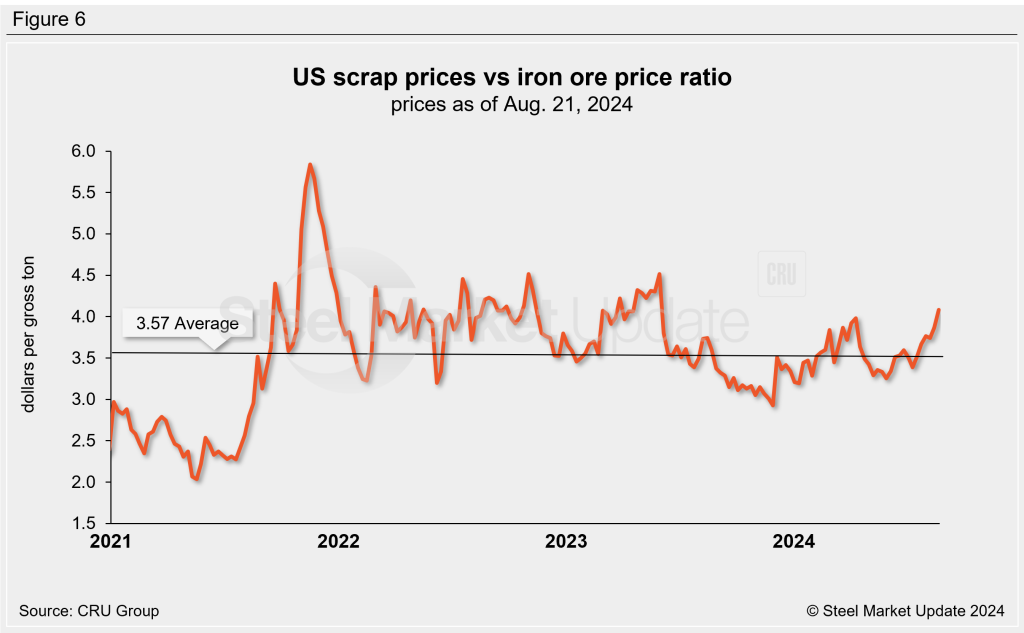
Zinc and aluminum
Zinc is used in galvanized and other coated steel products. Following the multi-year lows seen last year, spot prices rapidly increased earlier this year, reaching a one-year high of $1.40/lb in May. (This surge prompted some mills to increase their galvanized coating extras.) Those gains were short lived, being erased by the end of July. The latest LME cash price for zinc has recovered by 5% m/m to $1.27 per pound. Zinc prices are 7% lower than levels three months prior, but up 23% compared to August 2023 (Figure 7).
Aluminum prices, which factor into the price of Galvalume, also rose earlier this year. Prices climbed to a one-year high of $1.22/lb in May, but receded through July. The latest LME cash price has risen 8% m/m to $1.11/lb. Aluminum prices are 6% lower than tags three months prior, but 17% greater than levels seen this time last year. Note that aluminum spot prices sometimes have large swings and return to typical levels within a few days, as seen in Figure 7.
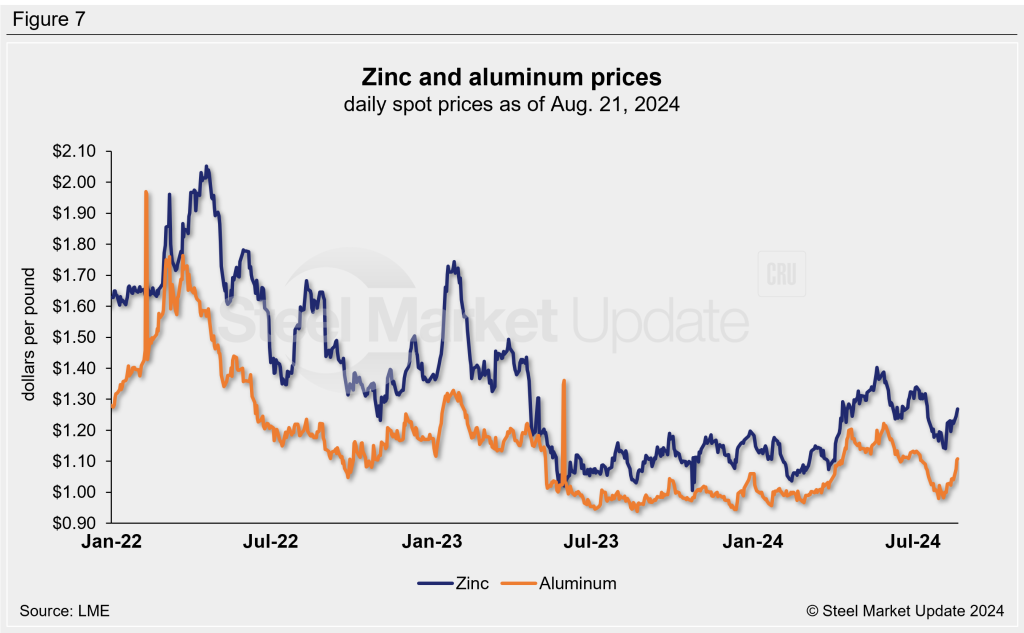

Brett Linton
Read more from Brett LintonLatest in SMU Data and Models

SMU Survey: Sheet lead times ease further, plate hits one-year high
Steel buyers responding to this week’s SMU market survey report a continued softening in sheet lead times. Meanwhile, plate lead times have moderately extended and are at a one-year high.

SMU Survey: Buyers report more price flexibility from mills
Nearly half of the steel buyers responding to this week’s SMU market survey say domestic mills are showing increased willingness to negotiate pricing on new spot orders. This marks a significant shift from the firmer stance mills held in prior weeks.

SMU Survey: Buyers’ Sentiment Indices fall
Current Sentiment Index dropped six points to +42 this week compared to two weeks earlier. It has fallen in every successive survey since reaching a 2025 high of +66 on Feb. 19.

March service center shipments and inventories report
Steel service center shipments and inventories report through March 2024.

Apparent steel supply contracts in February
The amount of finished steel that entered the US market in February receded from January’s peak, according to our analysis of Department of Commerce and American Iron and Steel Institute (AISI) data.
